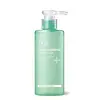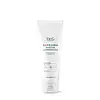What's inside
What's inside
 Benefits
Benefits

 Concerns
Concerns

 Ingredients Side-by-side
Ingredients Side-by-side

Water
Skin ConditioningPotassium Laureth Phosphate
EmulsifyingGlycerin
HumectantPotassium Cocoyl Glutamate
Acrylates/C10-30 Alkyl Acrylate Crosspolymer
Emulsion StabilisingButylene Glycol
HumectantAspartic Acid
MaskingSodium Cocoyl Glutamate
CleansingLauryl Hydroxysultaine
CleansingCoco-Glucoside
CleansingCaprylyl Glycol
EmollientGlyceryl Caprylate
EmollientPolyglyceryl-10 Laurate
Skin ConditioningCitrus Aurantium Dulcis Peel Oil
MaskingPolyglyceryl-10 Myristate
Skin ConditioningLavandula Angustifolia Oil
MaskingSodium Cocoyl Isethionate
CleansingDisodium EDTA
1,2-Hexanediol
Skin ConditioningQuillaja Saponaria Bark Extract
CleansingBifida Ferment Lysate
Skin ConditioningLactobacillus
Skin ConditioningLeuconostoc/Radish Root Ferment Filtrate
AntimicrobialMaltodextrin
AbsorbentMoringa Oleifera Seed Extract
Skin ConditioningOlea Europaea Oil Unsaponifiables
Skin ConditioningGlycine Soja Oil Unsaponifiables
EmollientTriticum Vulgare Germ Oil Unsaponifiables
EmollientPollen Extract
EmollientTheanine
EmollientMilk Lipids
Skin ConditioningGlutathione
Water, Potassium Laureth Phosphate, Glycerin, Potassium Cocoyl Glutamate, Acrylates/C10-30 Alkyl Acrylate Crosspolymer, Butylene Glycol, Aspartic Acid, Sodium Cocoyl Glutamate, Lauryl Hydroxysultaine, Coco-Glucoside, Caprylyl Glycol, Glyceryl Caprylate, Polyglyceryl-10 Laurate, Citrus Aurantium Dulcis Peel Oil, Polyglyceryl-10 Myristate, Lavandula Angustifolia Oil, Sodium Cocoyl Isethionate, Disodium EDTA, 1,2-Hexanediol, Quillaja Saponaria Bark Extract, Bifida Ferment Lysate, Lactobacillus, Leuconostoc/Radish Root Ferment Filtrate, Maltodextrin, Moringa Oleifera Seed Extract, Olea Europaea Oil Unsaponifiables, Glycine Soja Oil Unsaponifiables, Triticum Vulgare Germ Oil Unsaponifiables, Pollen Extract, Theanine, Milk Lipids, Glutathione
Water
Skin ConditioningStearic Acid
CleansingGlycerin
HumectantLauric Acid
CleansingPotassium Hydroxide
BufferingMyristic Acid
CleansingGlyceryl Stearate
EmollientPEG-100 Stearate
Propylene Glycol
HumectantCocamidopropyl Betaine
CleansingBeeswax
Emulsion StabilisingSodium Chloride
MaskingPolysorbate 20
EmulsifyingDisodium EDTA
Hydroxyethylcellulose
Emulsion StabilisingButylene Glycol
HumectantOryza Sativa Bran Extract
Skin ConditioningCarica Papaya Fruit Extract
Skin ConditioningAlthaea Rosea Flower Extract
Skin ConditioningAloe Barbadensis Leaf Extract
EmollientCitrus Grandis Peel Extract
AstringentGinkgo Biloba Leaf Extract
Skin ConditioningCitrus Limon Fruit Extract
MaskingSodium PCA
HumectantPhenoxyethanol
PreservativeEthylhexylglycerin
Skin ConditioningParfum
MaskingWater, Stearic Acid, Glycerin, Lauric Acid, Potassium Hydroxide, Myristic Acid, Glyceryl Stearate, PEG-100 Stearate, Propylene Glycol, Cocamidopropyl Betaine, Beeswax, Sodium Chloride, Polysorbate 20, Disodium EDTA, Hydroxyethylcellulose, Butylene Glycol, Oryza Sativa Bran Extract, Carica Papaya Fruit Extract, Althaea Rosea Flower Extract, Aloe Barbadensis Leaf Extract, Citrus Grandis Peel Extract, Ginkgo Biloba Leaf Extract, Citrus Limon Fruit Extract, Sodium PCA, Phenoxyethanol, Ethylhexylglycerin, Parfum
 Reviews
Reviews

Ingredients Explained
These ingredients are found in both products.
Ingredients higher up in an ingredient list are typically present in a larger amount.
Butylene Glycol (or BG) is used within cosmetic products for a few different reasons:
Overall, Butylene Glycol is a safe and well-rounded ingredient that works well with other ingredients.
Though this ingredient works well with most skin types, some people with sensitive skin may experience a reaction such as allergic rashes, closed comedones, or itchiness.
Learn more about Butylene GlycolDisodium EDTA plays a role in making products more stable by aiding other preservatives.
It is a chelating agent, meaning it neutralizes metal ions that may be found in a product.
Disodium EDTA is a salt of edetic acid and is found to be safe in cosmetic ingredients.
Learn more about Disodium EDTAGlycerin is already naturally found in your skin. It helps moisturize and protect your skin.
A study from 2016 found glycerin to be more effective as a humectant than AHAs and hyaluronic acid.
As a humectant, it helps the skin stay hydrated by pulling moisture to your skin. The low molecular weight of glycerin allows it to pull moisture into the deeper layers of your skin.
Hydrated skin improves your skin barrier; Your skin barrier helps protect against irritants and bacteria.
Glycerin has also been found to have antimicrobial and antiviral properties. Due to these properties, glycerin is often used in wound and burn treatments.
In cosmetics, glycerin is usually derived from plants such as soybean or palm. However, it can also be sourced from animals, such as tallow or animal fat.
This ingredient is organic, colorless, odorless, and non-toxic.
Glycerin is the name for this ingredient in American English. British English uses Glycerol/Glycerine.
Learn more about GlycerinWater. It's the most common cosmetic ingredient of all. You'll usually see it at the top of ingredient lists, meaning that it makes up the largest part of the product.
So why is it so popular? Water most often acts as a solvent - this means that it helps dissolve other ingredients into the formulation.
You'll also recognize water as that liquid we all need to stay alive. If you see this, drink a glass of water. Stay hydrated!
Learn more about Water